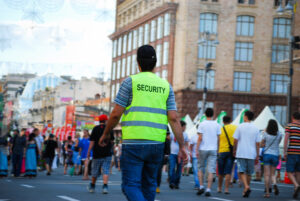Ensuring Safety and Security at Events: A Comprehensive Guide for Planners

In light of recent protests by the “Just Stop Oil” group at Wimbledon and the Ashes, we take a look at some key points to consider when it comes to safety and event security. As planners, we have a crucial responsibility in ensuring the safety of those who attend our events — regardless of their size or nature. With security measures playing such a key part in the planning process, this blog will explore the best practice guidelines that all planners should follow to ensure that each and every event takes place in a safe and secure environment.
Conduct Thorough Risk Assessments
Before organising an event, it’s essential to conduct a comprehensive risk assessment to identify any and all potential hazards or security vulnerabilities. This assessment should take into account points such as venue infrastructure and crowd management strategies as well as threats posed by natural disasters, terrorism, and medical emergencies. Technological threats — such as data breaches and information security incidents — should also be considered during the course of any risk assessment process.
Collaborate with Venue Authorities
A strong relationship with the on-site staff at your chosen venue is crucial in ensuring that your event unfolds safely. As a planner, you should take the time to make yourself aware of the venue’s existing security measures and emergency response protocols along with any other site-specific evacuation plans. Direct collaboration with on-site staff can help to address any additional safety requirements specific to your event. Regular communication with the venue will help you align your plans with their existing infrastructure, ensuring a seamless integration of safety and security measures. For planners in the UK, it’s also worth being aware of the requirements placed upon venues by Martyn’s Law, a piece of legislation that has been enacted to offer greater protection against acts of terrorism.
Implement Crowd Management Strategies
Crowd control and management is a significant challenge at events, but the following points can help to mitigate the dangers potentially posed by overcrowding — and especially the threat posed by overcrowding in an emergency situation:
- Clearly marked exits and evacuation routes: Ensure that exits and evacuation routes are clearly signposted and easily accessible throughout the venue.
- Well-trained security personnel: Hire trained security personnel who are experienced in crowd management and emergency response. They should be positioned strategically to monitor and control crowd movement.
- Controlled access points: Use fencing, barriers, and ticketing systems to regulate entry and prevent unauthorised access. This helps in managing crowd flow and maintaining security.
- Communication systems: Establish effective communication systems among event staff, security personnel, and emergency services. This ensures a prompt response in case of any security-related incidents.
Create Emergency Response Plans
It’s also important to prepare detailed emergency response plans in collaboration with relevant stakeholders. These plans should include protocols for various scenarios, such as medical emergencies, fires, natural disasters, and security threats. Key components of an emergency response plan should include:
- Evacuation procedures: Clearly define evacuation routes and communicate them to attendees. Conduct drills and rehearsals to familiarise staff and volunteers with the evacuation procedures.
- Medical support: Arrange for medical personnel, first aid stations, and emergency medical services on-site. Train event staff in basic first aid and CPR. Ensure that any on-site medical equipment (i.e. defibrillators) is in good working order.
- Communication protocols: Establish a centralised communication system to disseminate critical information to attendees, staff, and emergency services during an emergency. This might include public address systems, text messaging services, or mobile applications.
- Collaboration with local authorities: Maintain open communication with local law enforcement, fire departments, and other relevant authorities. They can provide guidance and support during emergencies.
Enhance Technological Security Measures
Incorporate technological solutions to enhance security measures at events. Some best practices include:
- Video surveillance: Install CCTV cameras in strategic locations to monitor crowd behaviour and identify potential security threats.
- Access control systems: Utilise access control measures, such as ticketing systems, ID checks, or wristbands, to ensure only authorised individuals enter restricted areas.
- Cybersecurity: Safeguard digital systems and networks by implementing robust cybersecurity measures. Protect attendee information and prevent unauthorised access to sensitive data.
- Mobile applications: Develop event-specific mobile applications that provide attendees with real-time updates, emergency notifications, and a means to report suspicious activities.
Prioritising safety and security is a crucial aspect of any successful event. By taking a considered, multifaceted, and comprehensive approach, event planners can mitigate potential risks and dangers to provide a safe environment for attendees, delegates, and exhibitors alike.
Running live, virtual or hybrid events? Give your attendees an event experience they’ll remember with technology you can rely on. Learn how Eventsforce can make your next event fabulous and successful. Book your personalised demo now.
